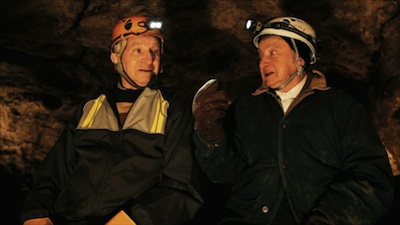By Emily K. Alhadeff , Associate Editor, JTNews
It’s hard to imagine, with the abundance of Holocaust literature and films, that stories of mind-blowing value still remain largely untold. In 1942 Ukraine, 38 men, women and children slid deep into the earth to spend 511 days hiding from the Nazis and their neighbors in pitch-black caves. Though they all emerged from the cave, their story, for the most part, remained until recently underground.
When adventure-seeking spelunker Chris Nicola traveled to Ukraine in the ‘90s to trace his ancestry, he heard rumors of Jews who hid in the caves during the war. Indeed, deep inside Priest’s Grotto he came across a shoe, a comb, and an antique key and buttons. Nicola began the intensive process of locating the cave dwellers, whose fates no one in that part of Ukraine knew anything about. Eventually, back in North America, he found 14 of the survivors. So he began to tell their story.
That story is coming to the screen. Part reenactment, part documentary, “No Place on Earth,” opens May 3 at the Varsity Theater in Seattle.
When the Gestapo circled the village of Korolowka and rounded up the Jews to send to the camps or to dig their own graves before killing them, Esther Stermer knew that her family would submit to neither. Instead, she, her husband and their six children, along with four other families, fled about five miles away and slid through a narrow passage into Verteba cave. Verteba is exceptional among caves, carbon dating back to 5,000 BCE for probable use as a burial grounds (roughly 3,600 years before Moses’ birth, for perspective). Finding it unsuitable for life due to poor ventilation and lack of water (not to mention a Gestapo invasion), the group moved to nearby Priest’s Grotto, the 11th longest cave in the world and so complex that even experienced cavers take the fatal risk of getting lost.
“No Place on Earth” tells the harrowing story of what may be the longest-ever human underground existence, and follows Sam and Saul Stermer and Sonia and Sima Dodyk back to Ukraine to enter the caves that protected them 71 years ago.
In a phone conversation with JTNews, director Janet Tobias said a former colleague brought her the story, which was featured in National Geographic in 2004 and in Nicola’s book, “The Secret of Priest’s Grotto.” Though she was cautious at first to venture into Holocaust filmmaking territory, the Stermers won her over with their story.
“They had such pride in telling it,” she said. “They had such spirit in telling it. I thought, “˜I just need to do this.’”
Once the Stermers decided they could trust Tobias with their story, the production crew was tasked with a number of challenges, namely, transporting four elderly people down into a dangerous cave, normally accessed by a 100-foot-long rusty pipe. They built steps inside the cave and kept an ambulance on call. And then there was the gear.
“That was all very, very complicated,” said Tobias.
But the results made it worth it.
“For each of them, it was watching a person go back in time,” Tobias reflected. “Watching them remember things that happened to them at that age was really profound.”
In a Manichean twist, “I’d always thought of this as a story where light and dark were switched,” said Tobias. While the dark place was safe, “the scary place was outside…the second you popped your head out of the cave you could be dead.”
Tobias recalls being in the cave with the Stermers when Saul told Sam to turn out their light. Encased in darkness, Sam said, “Now I feel good; now I recognize where I am.”
“They loved the cave,” said Tobias. “It’s like a second mother to them.”
The group’s survival is credited to their skills and resources, said Tobias, from Esther’s “Golda Meir-like” leadership to others’ engineering skills, wits, connections with the outside world for food, and bravery.
Tobias hopes educators will use the film in the classroom.
“The way you stop genocide is one person at a time,” she said. “It is the younger generation’s opportunity and responsibility.” Kids, she continued, should see “how crazy brave and wonderful young people can be.”
On the film’s website, Nicola is quoted as saying, “I learned the Holocaust isn’t one story of how 6 million people perished; it’s 6 million individual stories.” From “Defiance” to “In Darkness” to “Inglourious Basterds,” tales of resistance and survival are joining the vast library of Holocaust stories focused on persecution and senseless acts of inhumanity.
“They came out, and they had an intact family, and no one had an intact family,” said Tobias. “So they view their experience with incredible pride. It was a story of triumph, not defeat.”
When the film screened at the Toronto Film Festival, the survivors in attendance received a standing ovation.
“How incredibly right and deserved,” Tobias thought at the time.
“They’ve kept their humanity and spirit,” she said. “I have a 92-year-old who laughs on the phone. It’s about as good as it gets.”
